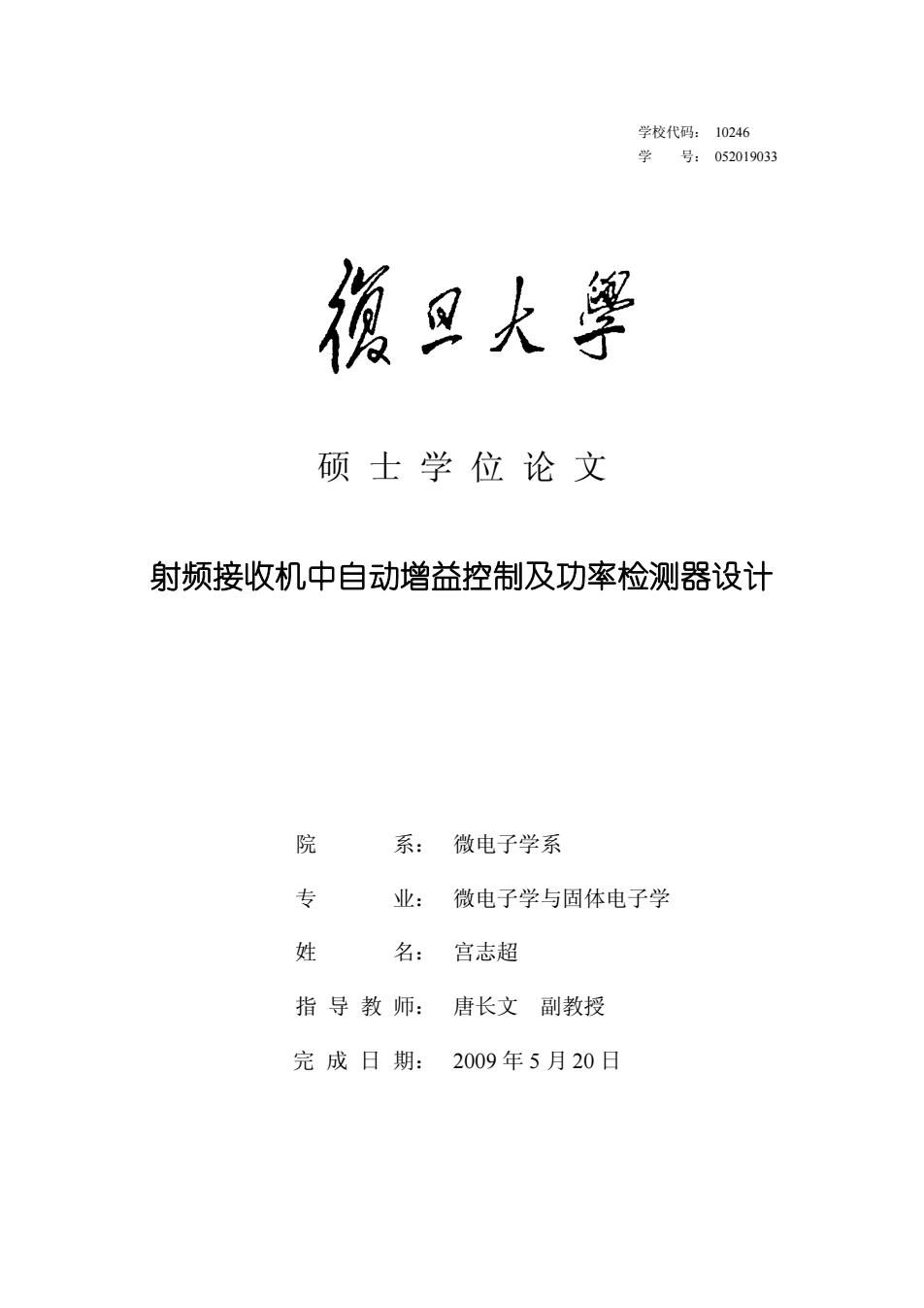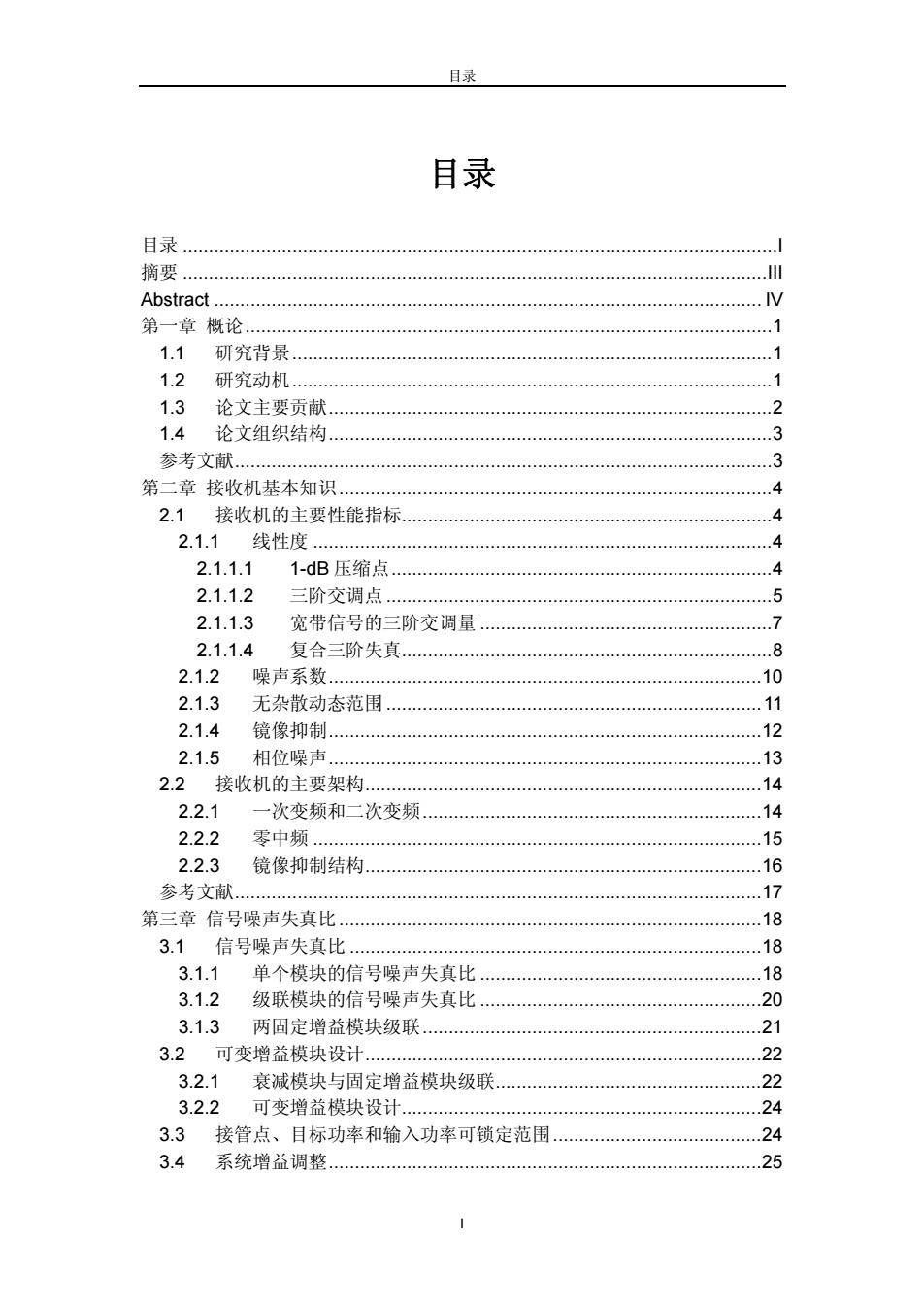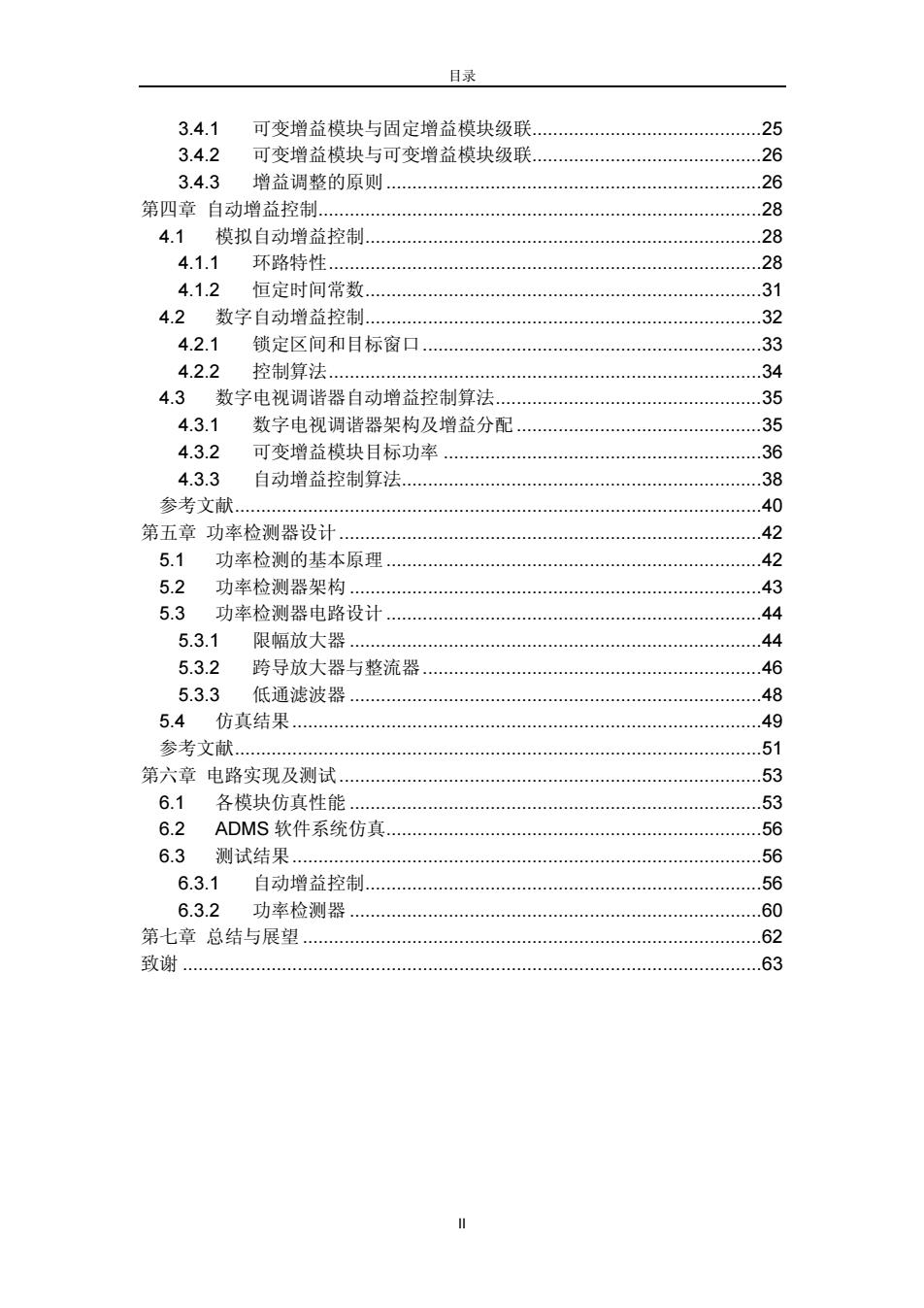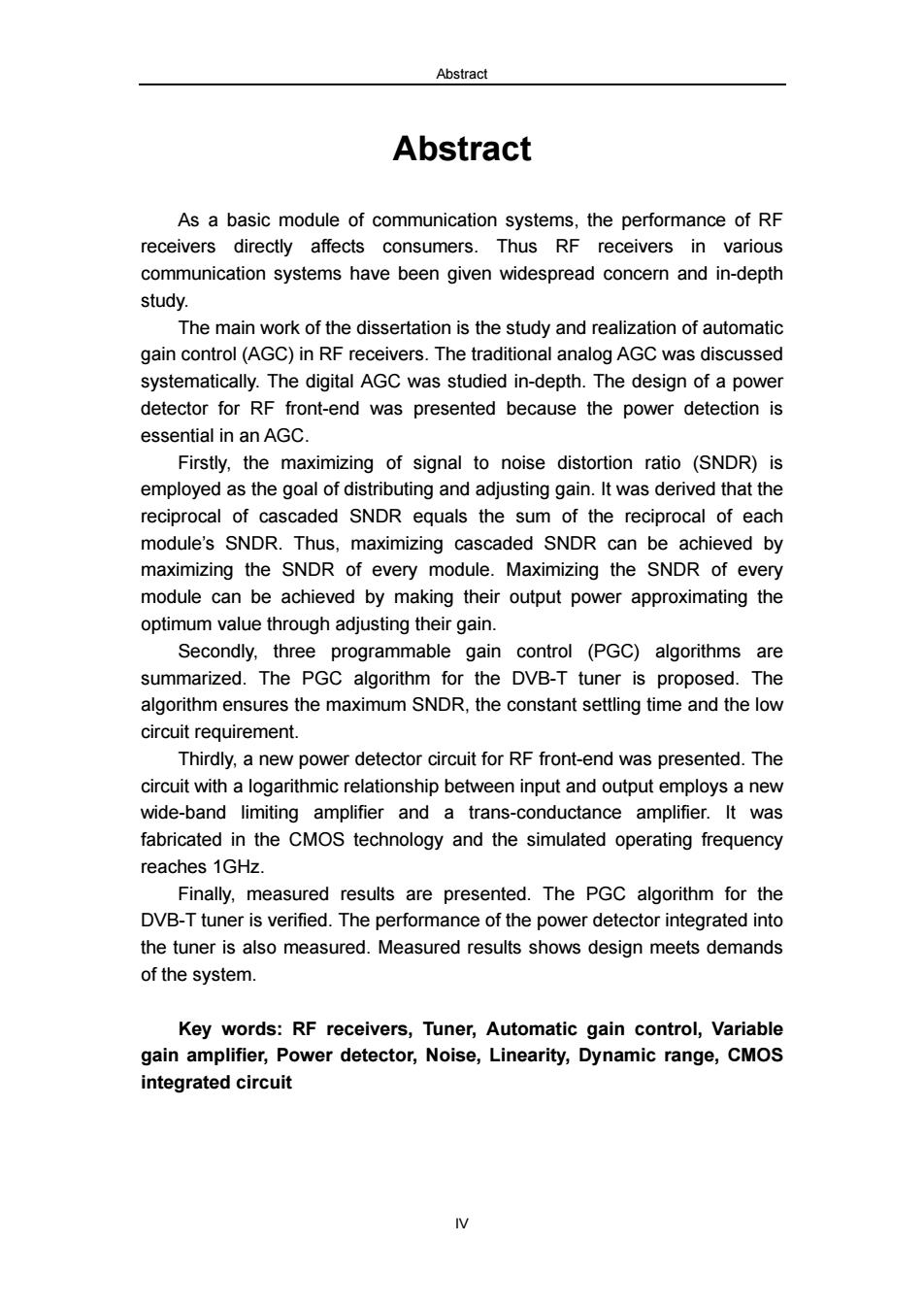
学校代码: 10246 学号:052019033 復足大壑 硕士学位论文 射频接收机中自动增益控制及功率检测器设计 院 系: 微电子学系 专 业: 微电子学与固体电子学 姓 名: 宫志超 指导教师: 唐长文副教授 完成日期: 2009年5月20日
学校代码: 10246 学 号: 052019033 硕 士 学 位 论 文 射频接收机中自动增益控制及功率检测器设计 院 系: 微电子学系 专 业: 微电子学与固体电子学 姓 名: 宫志超 指 导 教 师: 唐长文 副教授 完 成 日 期: 2009 年 5 月 20 日

目录 目录 目录… / 摘要 l Abstract.. IV 第一章概论。 ·7 1.1 研究背景 ·7 1.2 研究动机 ·7 1.3 论文主要贡献 2 1.4 论文组织结构 3 参考文献 3 第二章接收机基本知识 2.1接收机的主要性能指标. 又 2.1.1线性度 A 2.1.1.1 1-dB压缩点.. g 2.1.1.2 三阶交调点… 2.1.1.3 宽带信号的三阶交调量 .7 2.1.1.4 复合三阶失真 8 2.1.2 噪声系数… 10 2.1.3 无杂散动态范围 .11 2.1.4 镜像抑制 12 2.1.5 相位噪声… 13 2.2接收机的主要架构 .14 2.2.1 次变频和二次变频 .14 2.2.2 零中频 .15 2.2.3 镜像抑制结构 .16 参考文献 17 第三章信号噪声失真比 18 3.1信号噪声失真比 18 3.1.1 单个模块的信号噪声失真比 18 3.1.2 级联模块的信号噪声失真比 。。 20 3.1.3 两固定增益模块级联.… .21 3.2可变增益模块设计 22 3.2.1 衰减模块与固定增益模块级联 .22 3.2.2 可变增益模块设计.… 24 3.3接管点、目标功率和输入功率可锁定范围… .24 3.4 系统增益调整… .25
目录 I 目录 目录 ..................................................................................................................I 摘要 ................................................................................................................III Abstract ......................................................................................................... IV 第一章 概论.....................................................................................................1 1.1 研究背景............................................................................................1 1.2 研究动机............................................................................................1 1.3 论文主要贡献.....................................................................................2 1.4 论文组织结构.....................................................................................3 参考文献.......................................................................................................3 第二章 接收机基本知识...................................................................................4 2.1 接收机的主要性能指标.......................................................................4 2.1.1 线性度 ........................................................................................4 2.1.1.1 1-dB 压缩点.........................................................................4 2.1.1.2 三阶交调点..........................................................................5 2.1.1.3 宽带信号的三阶交调量 ........................................................7 2.1.1.4 复合三阶失真.......................................................................8 2.1.2 噪声系数...................................................................................10 2.1.3 无杂散动态范围........................................................................11 2.1.4 镜像抑制...................................................................................12 2.1.5 相位噪声...................................................................................13 2.2 接收机的主要架构............................................................................14 2.2.1 一次变频和二次变频.................................................................14 2.2.2 零中频 ......................................................................................15 2.2.3 镜像抑制结构............................................................................16 参考文献.....................................................................................................17 第三章 信号噪声失真比.................................................................................18 3.1 信号噪声失真比 ...............................................................................18 3.1.1 单个模块的信号噪声失真比 ......................................................18 3.1.2 级联模块的信号噪声失真比 ......................................................20 3.1.3 两固定增益模块级联.................................................................21 3.2 可变增益模块设计............................................................................22 3.2.1 衰减模块与固定增益模块级联...................................................22 3.2.2 可变增益模块设计.....................................................................24 3.3 接管点、目标功率和输入功率可锁定范围........................................24 3.4 系统增益调整...................................................................................25

目录 3.4.1 可变增益模块与固定增益模块级联 25 3.4.2 可变增益模块与可变增益模块级联 。。 .26 3.4.3 增益调整的原则 .26 第四章自动增益控制. .28 4.1模拟自动增益控制. .28 4.1.1 环路特性 28 4.1.2 恒定时间常数, .31 4.2数字自动增益控制. 32 4.2.1锁定区间和目标窗口.… 33 4.2.2控制算法.… .34 4.3数字电视调谐器自动增益控制算法 35 4.3.1数字电视调谐器架构及增益分配 .35 4.3.2 可变增益模块目标功率 .36 4.3.3 自动增益控制算法, .38 参考文献 .40 第五章功率检测器设计 .42 5.1 功率检测的基本原理 42 5.2 功率检测器架构 .43 5.3 功率检测器电路设计. ..44 5.3.1 限幅放大器 .44 5.3.2 跨导放大器与整流器 .46 5.3.3 低通滤波器 .48 5.4仿真结果 .49 参考文献, ..51 第六章电路实现及测试 .53 6.1各模块仿真性能 ..53 6.2 ADMS软件系统仿真. .56 6.3测试结果. ..56 6.3.1自动增益控制 56 6.3.2 功率检测器 60 第七章总结与展望 .62 致谢 .63
目录 II 3.4.1 可变增益模块与固定增益模块级联............................................25 3.4.2 可变增益模块与可变增益模块级联............................................26 3.4.3 增益调整的原则........................................................................26 第四章 自动增益控制.....................................................................................28 4.1 模拟自动增益控制............................................................................28 4.1.1 环路特性...................................................................................28 4.1.2 恒定时间常数............................................................................31 4.2 数字自动增益控制............................................................................32 4.2.1 锁定区间和目标窗口.................................................................33 4.2.2 控制算法...................................................................................34 4.3 数字电视调谐器自动增益控制算法...................................................35 4.3.1 数字电视调谐器架构及增益分配...............................................35 4.3.2 可变增益模块目标功率 .............................................................36 4.3.3 自动增益控制算法.....................................................................38 参考文献.....................................................................................................40 第五章 功率检测器设计.................................................................................42 5.1 功率检测的基本原理........................................................................42 5.2 功率检测器架构 ...............................................................................43 5.3 功率检测器电路设计........................................................................44 5.3.1 限幅放大器 ...............................................................................44 5.3.2 跨导放大器与整流器.................................................................46 5.3.3 低通滤波器 ...............................................................................48 5.4 仿真结果..........................................................................................49 参考文献.....................................................................................................51 第六章 电路实现及测试.................................................................................53 6.1 各模块仿真性能 ...............................................................................53 6.2 ADMS 软件系统仿真........................................................................56 6.3 测试结果..........................................................................................56 6.3.1 自动增益控制............................................................................56 6.3.2 功率检测器 ...............................................................................60 第七章 总结与展望 ........................................................................................62 致谢 ...............................................................................................................63

摘要 摘要 射频接收机是通信系统中的基本模块,作为接收终端其性能直接影响到用 户,因此在各种通信系统中它们都得到了人们广泛的关注和深入的研究。 本论文的主要工作是射频接收机中的自动增益控制的研究与实现。总结了 传统的模拟自动增益控制,并深入分析了数字自动增益控制。由于功率检测是 自动增益控制中的必需模块,也设计了一个应用于射频前端的功率检测器。 首先,采用信号噪声失真比的最大化作为分配及调整增益的原则。推导出 级联信号噪声失真比的倒数等于各个模块信号噪声失真比倒数之和,因此各个 模块的信号噪声失真比最大化,可以使得级联系统的信号噪声失真比最大化。 通过调整增益使各模块输出功率趋近最优值可以最大化各模块的信号噪声失真 比。 然后,论述了传统的模拟自动增益控制,详细讨论了数字自动增益控制。 总结了三种数字自动增益控制可以采用的算法。作为一个应用的例子,分析并 设计了数字电视调谐器自动增益控制的算法,算法保证了信号噪声失真比的最 大化,具有恒定的锁定时间。 另外,本文设计了一个应用于射频前端的功率检测器电路。采用了改进的 宽带限幅放大器以及全新的跨导放大器,输出信号与输入信号功率成对数关系, 用CMOS工艺实现,仿真工作频率可以达到1GHz。 最后,通过数字电视调谐器的流片测试了自动增益控制算法的性能,同时 也测试了系统集成的功率检测器的各项指标。测试结果验证了自动增益控制的 算法的正确性,功率检测器的性能也达到指标要求。 关键词:射频接收机,数字电视调谐器,自动增益控制,可变增益放大器, 功率检测器,噪声,线性度,动态范围,CMOS集成电路设计 中图分类号:TN432 本论文工作受到国家高科技研究发展计划资助(项目编号:2007AA01Z282)
摘要 III 摘要 射频接收机是通信系统中的基本模块,作为接收终端其性能直接影响到用 户,因此在各种通信系统中它们都得到了人们广泛的关注和深入的研究。 本论文的主要工作是射频接收机中的自动增益控制的研究与实现。总结了 传统的模拟自动增益控制,并深入分析了数字自动增益控制。由于功率检测是 自动增益控制中的必需模块,也设计了一个应用于射频前端的功率检测器。 首先,采用信号噪声失真比的最大化作为分配及调整增益的原则。推导出 级联信号噪声失真比的倒数等于各个模块信号噪声失真比倒数之和,因此各个 模块的信号噪声失真比最大化,可以使得级联系统的信号噪声失真比最大化。 通过调整增益使各模块输出功率趋近最优值可以最大化各模块的信号噪声失真 比。 然后,论述了传统的模拟自动增益控制,详细讨论了数字自动增益控制。 总结了三种数字自动增益控制可以采用的算法。作为一个应用的例子,分析并 设计了数字电视调谐器自动增益控制的算法,算法保证了信号噪声失真比的最 大化,具有恒定的锁定时间。 另外,本文设计了一个应用于射频前端的功率检测器电路。采用了改进的 宽带限幅放大器以及全新的跨导放大器,输出信号与输入信号功率成对数关系, 用 CMOS 工艺实现,仿真工作频率可以达到 1GHz。 最后,通过数字电视调谐器的流片测试了自动增益控制算法的性能,同时 也测试了系统集成的功率检测器的各项指标。测试结果验证了自动增益控制的 算法的正确性,功率检测器的性能也达到指标要求。 关键词:射频接收机,数字电视调谐器,自动增益控制,可变增益放大器, 功率检测器,噪声,线性度,动态范围,CMOS 集成电路设计 中图分类号:TN432 本论文工作受到国家高科技研究发展计划资助(项目编号:2007AA01Z282)

Abstract Abstract As a basic module of communication systems,the performance of RF receivers directly affects consumers.Thus RF receivers in various communication systems have been given widespread concern and in-depth study. The main work of the dissertation is the study and realization of automatic gain control(AGC)in RF receivers.The traditional analog AGC was discussed systematically.The digital AGC was studied in-depth.The design of a power detector for RF front-end was presented because the power detection is essential in an AGC. Firstly,the maximizing of signal to noise distortion ratio (SNDR)is employed as the goal of distributing and adjusting gain.It was derived that the reciprocal of cascaded SNDR equals the sum of the reciprocal of each module's SNDR.Thus,maximizing cascaded SNDR can be achieved by maximizing the SNDR of every module.Maximizing the SNDR of every module can be achieved by making their output power approximating the optimum value through adjusting their gain. Secondly,three programmable gain control (PGC)algorithms are summarized.The PGC algorithm for the DVB-T tuner is proposed.The algorithm ensures the maximum SNDR,the constant settling time and the low circuit requirement. Thirdly,a new power detector circuit for RF front-end was presented.The circuit with a logarithmic relationship between input and output employs a new wide-band limiting amplifier and a trans-conductance amplifier.It was fabricated in the CMOS technology and the simulated operating frequency reaches 1GHz. Finally,measured results are presented.The PGC algorithm for the DVB-T tuner is verified.The performance of the power detector integrated into the tuner is also measured.Measured results shows design meets demands of the system. Key words:RF receivers,Tuner,Automatic gain control,Variable gain amplifier,Power detector,Noise,Linearity,Dynamic range,CMOS integrated circuit N
Abstract IV Abstract As a basic module of communication systems, the performance of RF receivers directly affects consumers. Thus RF receivers in various communication systems have been given widespread concern and in-depth study. The main work of the dissertation is the study and realization of automatic gain control (AGC) in RF receivers. The traditional analog AGC was discussed systematically. The digital AGC was studied in-depth. The design of a power detector for RF front-end was presented because the power detection is essential in an AGC. Firstly, the maximizing of signal to noise distortion ratio (SNDR) is employed as the goal of distributing and adjusting gain. It was derived that the reciprocal of cascaded SNDR equals the sum of the reciprocal of each module’s SNDR. Thus, maximizing cascaded SNDR can be achieved by maximizing the SNDR of every module. Maximizing the SNDR of every module can be achieved by making their output power approximating the optimum value through adjusting their gain. Secondly, three programmable gain control (PGC) algorithms are summarized. The PGC algorithm for the DVB-T tuner is proposed. The algorithm ensures the maximum SNDR, the constant settling time and the low circuit requirement. Thirdly, a new power detector circuit for RF front-end was presented. The circuit with a logarithmic relationship between input and output employs a new wide-band limiting amplifier and a trans-conductance amplifier. It was fabricated in the CMOS technology and the simulated operating frequency reaches 1GHz. Finally, measured results are presented. The PGC algorithm for the DVB-T tuner is verified. The performance of the power detector integrated into the tuner is also measured. Measured results shows design meets demands of the system. Key words: RF receivers, Tuner, Automatic gain control, Variable gain amplifier, Power detector, Noise, Linearity, Dynamic range, CMOS integrated circuit